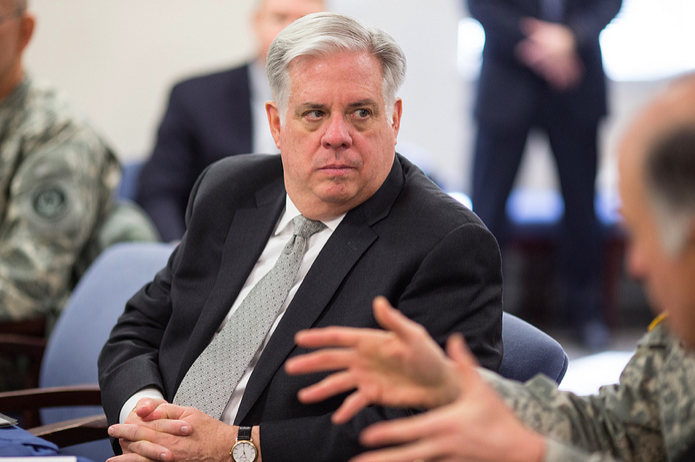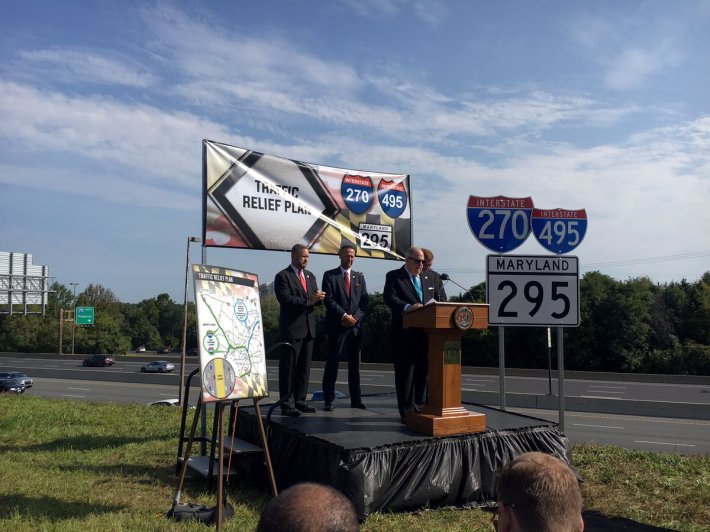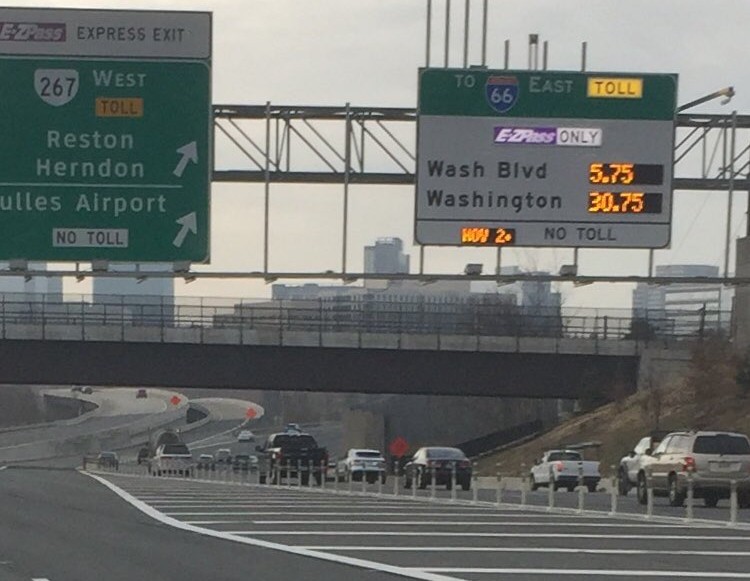Washington, D.C. is the nation's capital — and its suburbs could be moving towards becoming the nation's capital of privately owned express toll lanes.
The Virginia side of the Potomac has placed a big bet on such roadways, with 14 miles of pay lanes in the middle of the region's famous Beltway, reversible toll lanes along 29 miles of I-95, and construction under way on three more highway segments. Last September, Maryland Governor Larry Hogan announced an even more ambitious plan for his side of the river, covering 77 miles of the Beltway and I-270.
If these plans go forward, Marylanders face a rude awakening.
New data contradicts claims that the Virginia toll lanes have been a success story. The lanes remain bathed in red ink, and their owner, the Australian firm Transurban, seems to have raised tolls to the point where drivers are simply unwilling to pay more.
One new set of data comes from Donna Chen, a civil engineering professor at the University of Virginia. She has carefully analyzed toll rates and compared them with the traffic delays on the roads' untolled lanes.
Professor Chen found that at the peak of rush hour – 8 to 9 a.m. and 4:30 to 6 p.m. – Beltway tolls average between $1.50 and $1.80 per mile (somewhat lower on Fridays). Per-mile tolls on I-95 are usually lower, but still relatively expensive.

Another way to look at this is the cost of time gained by using the faster-moving toll lanes. Chen has calculated this, too: Solo drivers using the Beltway toll lanes regularly can expect to pay over time $159 for every hour of travel time they save during the morning rush hour and $101 in the evening. (Those are median values; the exact cost for every hour of time saved varies because the tolls are variable by time — but it's just as likely that the cost of an hour of time savings will be more than $159 as it is less.)
Time saved on I-95 is less expensive, but far from cheap. On the inner-suburb section of the road in Fairfax County, an hour saved costs $107 in the morning and $71 on the way home. Farther out, the price is somewhat lower: $77 and $39.
Facilities that charge these stiff rates can serve only the affluent, and they surely deserve their critics' label of "Lexus Lanes." Supporters try to argue that the lanes benefit all classes because, say, parents of young children can use them to bypass traffic jams and avoid late pickup charges at daycare. But using the Beltway toll lanes for such a purpose is a money-losing proposition — unless, of course, your daycare center charges $101 an hour for a late pickup.

As high as their tolls are, Transurban's Virginia properties are losing lots of money, and no improvement is in sight. The company's most recent report to stockholders, covering the year that ended in June, shows a pre-tax profit rate of negative 38% for the two facilities. And growth in traffic and revenue came to a screeching halt.
The Beltway toll lanes carried 1% fewer trips than a year earlier, and the year-over-year decline for the most recent quarter was 5%. Toll revenue grew a measly 4% for the year and dropped 13% in the final quarter. A year earlier, Transurban had reported growth of 17% in traffic and 32% in revenue.
Traffic and revenue growth on I-95 have also slowed, but it is not clear whether the dropoff is as severe as on the Beltway. The last two years of results on that highway are not directly comparable because a 3-mile extension of the toll lanes opened in December.
These two facilities earned $169 million in toll revenues last year. This did not even cover operating costs and interest on loans taken out to pay for construction, let alone pay back principal on the loans or give Transurban a return on its investment. The loss last year, before taxes, was $64 million.
But this loss did not show up on the bottom line. The company offset it with $80 million of paper income. The income was created by increasing the estimate of future profits from the Washington toll lanes. This turned past losses into assets, by allowing them to be deducted from the company's income taxes in years to come.
This opaque maneuver is hidden in a footnote on page 67 of another document, Transurban's audited financial statement. The company does not explain how it justifies increasing its estimate of future profits at a time when growth in traffic and revenue is cratering.
Why would Transurban engage in such financial legerdemain? One possible motivation is a desire to conceal the bad performance of the Virginia toll lanes while more toll lanes across the river hang in the balance. Governor Hogan, a Republican, is up for re-election in November, and his toll lane proposal is a big campaign issue. The Transurban presentation lists the Maryland plan as a major business opportunity.
More generally, the Virginia losses expose the fundamental weakness of the express toll lane business model. The cost of building new travel lanes on congested highways turns out to be much more than drivers think their benefits are worth. Northern Virginia is among the country's most affluent regions and has some of its most congested highways, so its drivers have the motivation and the ability to pay unusually high tolls. If express toll lanes lose money here, it's hard to see how they can make profits elsewhere.
Notwithstanding these gloomy financial prospects, however, pressure to build privatized toll lanes is unrelenting. There is money to be made in the here-and-now, by Wall Street dealmakers, construction contractors, and politicians in search of campaign contributions. (While the Beltway toll lanes were under construction, Transurban gave out $172,000 in illegal contributions to Virginia politicians.)
Only years later does the time come to absorb the losses. And by then someone else will be left holding the bag — the investors, taxpayers, and drivers who put up the financing and pay the tolls.
Transurban, for example, is responsible for losses only up to the amount it invested — but most of the financing for the Virginia Beltway project was a loan from the federal government. If the revenues aren't enough to pay back that loan, U.S. taxpayers will eat it. And Transurban is not paying any principal on its government loan, but simply paying part of the interest — the rest of the interest is being added to the principal to be paid back (maybe) in future years.
Given the shortfall on toll lanes in Virginia and the difficulties of privately owned toll roads elsewhere in the U.S. — coupled with the lessened willingness of lenders to make speculative loans since Great Recession — it's hard to believe that private financing will be available for toll lanes in Maryland without some kind of government guarantee or subsidy.
Ben Ross chairs the Maryland Transit Opportunities Coalition and is author of Dead End: Suburban Sprawl and the Rebirth of American Urbanism.






